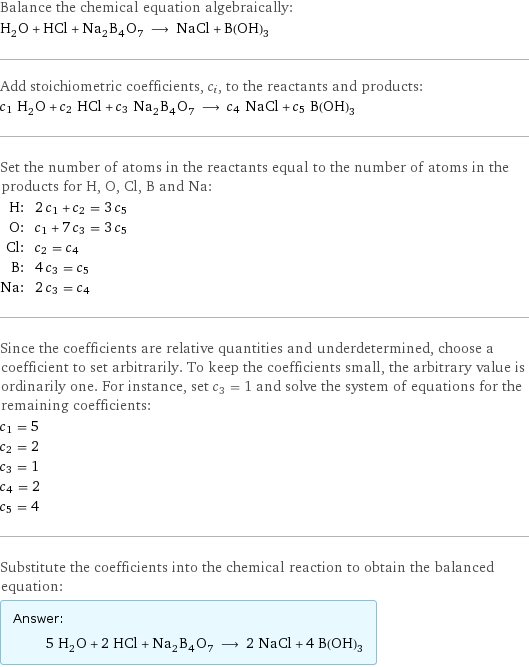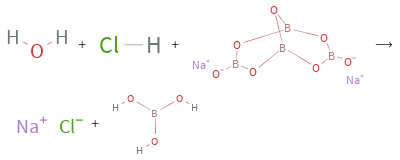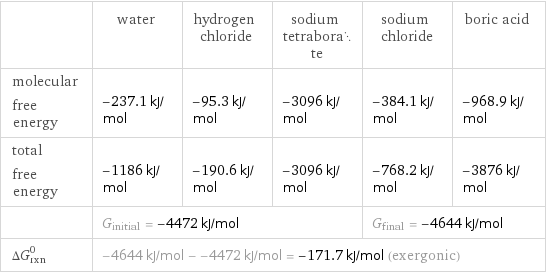Input interpretation

H_2O (water) + HCl (hydrogen chloride) + Na_2B_4O_7 (sodium tetraborate) ⟶ NaCl (sodium chloride) + B(OH)_3 (boric acid)
Balanced equation

Balance the chemical equation algebraically: H_2O + HCl + Na_2B_4O_7 ⟶ NaCl + B(OH)_3 Add stoichiometric coefficients, c_i, to the reactants and products: c_1 H_2O + c_2 HCl + c_3 Na_2B_4O_7 ⟶ c_4 NaCl + c_5 B(OH)_3 Set the number of atoms in the reactants equal to the number of atoms in the products for H, O, Cl, B and Na: H: | 2 c_1 + c_2 = 3 c_5 O: | c_1 + 7 c_3 = 3 c_5 Cl: | c_2 = c_4 B: | 4 c_3 = c_5 Na: | 2 c_3 = c_4 Since the coefficients are relative quantities and underdetermined, choose a coefficient to set arbitrarily. To keep the coefficients small, the arbitrary value is ordinarily one. For instance, set c_3 = 1 and solve the system of equations for the remaining coefficients: c_1 = 5 c_2 = 2 c_3 = 1 c_4 = 2 c_5 = 4 Substitute the coefficients into the chemical reaction to obtain the balanced equation: Answer: | | 5 H_2O + 2 HCl + Na_2B_4O_7 ⟶ 2 NaCl + 4 B(OH)_3
Structures

+ + ⟶ +
Names

water + hydrogen chloride + sodium tetraborate ⟶ sodium chloride + boric acid
Reaction thermodynamics
Enthalpy

| water | hydrogen chloride | sodium tetraborate | sodium chloride | boric acid molecular enthalpy | -285.8 kJ/mol | -92.3 kJ/mol | -3291 kJ/mol | -411.2 kJ/mol | -1094 kJ/mol total enthalpy | -1429 kJ/mol | -184.6 kJ/mol | -3291 kJ/mol | -822.4 kJ/mol | -4377 kJ/mol | H_initial = -4905 kJ/mol | | | H_final = -5200 kJ/mol | ΔH_rxn^0 | -5200 kJ/mol - -4905 kJ/mol = -294.8 kJ/mol (exothermic) | | | |
Gibbs free energy

| water | hydrogen chloride | sodium tetraborate | sodium chloride | boric acid molecular free energy | -237.1 kJ/mol | -95.3 kJ/mol | -3096 kJ/mol | -384.1 kJ/mol | -968.9 kJ/mol total free energy | -1186 kJ/mol | -190.6 kJ/mol | -3096 kJ/mol | -768.2 kJ/mol | -3876 kJ/mol | G_initial = -4472 kJ/mol | | | G_final = -4644 kJ/mol | ΔG_rxn^0 | -4644 kJ/mol - -4472 kJ/mol = -171.7 kJ/mol (exergonic) | | | |
Equilibrium constant
![Construct the equilibrium constant, K, expression for: H_2O + HCl + Na_2B_4O_7 ⟶ NaCl + B(OH)_3 Plan: • Balance the chemical equation. • Determine the stoichiometric numbers. • Assemble the activity expression for each chemical species. • Use the activity expressions to build the equilibrium constant expression. Write the balanced chemical equation: 5 H_2O + 2 HCl + Na_2B_4O_7 ⟶ 2 NaCl + 4 B(OH)_3 Assign stoichiometric numbers, ν_i, using the stoichiometric coefficients, c_i, from the balanced chemical equation in the following manner: ν_i = -c_i for reactants and ν_i = c_i for products: chemical species | c_i | ν_i H_2O | 5 | -5 HCl | 2 | -2 Na_2B_4O_7 | 1 | -1 NaCl | 2 | 2 B(OH)_3 | 4 | 4 Assemble the activity expressions accounting for the state of matter and ν_i: chemical species | c_i | ν_i | activity expression H_2O | 5 | -5 | ([H2O])^(-5) HCl | 2 | -2 | ([HCl])^(-2) Na_2B_4O_7 | 1 | -1 | ([Na2B4O7])^(-1) NaCl | 2 | 2 | ([NaCl])^2 B(OH)_3 | 4 | 4 | ([B(OH)3])^4 The equilibrium constant symbol in the concentration basis is: K_c Mulitply the activity expressions to arrive at the K_c expression: Answer: | | K_c = ([H2O])^(-5) ([HCl])^(-2) ([Na2B4O7])^(-1) ([NaCl])^2 ([B(OH)3])^4 = (([NaCl])^2 ([B(OH)3])^4)/(([H2O])^5 ([HCl])^2 [Na2B4O7])](../image_source/ebf036cc908ced398d9624a69f3371b2.png)
Construct the equilibrium constant, K, expression for: H_2O + HCl + Na_2B_4O_7 ⟶ NaCl + B(OH)_3 Plan: • Balance the chemical equation. • Determine the stoichiometric numbers. • Assemble the activity expression for each chemical species. • Use the activity expressions to build the equilibrium constant expression. Write the balanced chemical equation: 5 H_2O + 2 HCl + Na_2B_4O_7 ⟶ 2 NaCl + 4 B(OH)_3 Assign stoichiometric numbers, ν_i, using the stoichiometric coefficients, c_i, from the balanced chemical equation in the following manner: ν_i = -c_i for reactants and ν_i = c_i for products: chemical species | c_i | ν_i H_2O | 5 | -5 HCl | 2 | -2 Na_2B_4O_7 | 1 | -1 NaCl | 2 | 2 B(OH)_3 | 4 | 4 Assemble the activity expressions accounting for the state of matter and ν_i: chemical species | c_i | ν_i | activity expression H_2O | 5 | -5 | ([H2O])^(-5) HCl | 2 | -2 | ([HCl])^(-2) Na_2B_4O_7 | 1 | -1 | ([Na2B4O7])^(-1) NaCl | 2 | 2 | ([NaCl])^2 B(OH)_3 | 4 | 4 | ([B(OH)3])^4 The equilibrium constant symbol in the concentration basis is: K_c Mulitply the activity expressions to arrive at the K_c expression: Answer: | | K_c = ([H2O])^(-5) ([HCl])^(-2) ([Na2B4O7])^(-1) ([NaCl])^2 ([B(OH)3])^4 = (([NaCl])^2 ([B(OH)3])^4)/(([H2O])^5 ([HCl])^2 [Na2B4O7])
Rate of reaction
![Construct the rate of reaction expression for: H_2O + HCl + Na_2B_4O_7 ⟶ NaCl + B(OH)_3 Plan: • Balance the chemical equation. • Determine the stoichiometric numbers. • Assemble the rate term for each chemical species. • Write the rate of reaction expression. Write the balanced chemical equation: 5 H_2O + 2 HCl + Na_2B_4O_7 ⟶ 2 NaCl + 4 B(OH)_3 Assign stoichiometric numbers, ν_i, using the stoichiometric coefficients, c_i, from the balanced chemical equation in the following manner: ν_i = -c_i for reactants and ν_i = c_i for products: chemical species | c_i | ν_i H_2O | 5 | -5 HCl | 2 | -2 Na_2B_4O_7 | 1 | -1 NaCl | 2 | 2 B(OH)_3 | 4 | 4 The rate term for each chemical species, B_i, is 1/ν_i(Δ[B_i])/(Δt) where [B_i] is the amount concentration and t is time: chemical species | c_i | ν_i | rate term H_2O | 5 | -5 | -1/5 (Δ[H2O])/(Δt) HCl | 2 | -2 | -1/2 (Δ[HCl])/(Δt) Na_2B_4O_7 | 1 | -1 | -(Δ[Na2B4O7])/(Δt) NaCl | 2 | 2 | 1/2 (Δ[NaCl])/(Δt) B(OH)_3 | 4 | 4 | 1/4 (Δ[B(OH)3])/(Δt) (for infinitesimal rate of change, replace Δ with d) Set the rate terms equal to each other to arrive at the rate expression: Answer: | | rate = -1/5 (Δ[H2O])/(Δt) = -1/2 (Δ[HCl])/(Δt) = -(Δ[Na2B4O7])/(Δt) = 1/2 (Δ[NaCl])/(Δt) = 1/4 (Δ[B(OH)3])/(Δt) (assuming constant volume and no accumulation of intermediates or side products)](../image_source/eb5946667af4b5fc19130a5404e1f033.png)
Construct the rate of reaction expression for: H_2O + HCl + Na_2B_4O_7 ⟶ NaCl + B(OH)_3 Plan: • Balance the chemical equation. • Determine the stoichiometric numbers. • Assemble the rate term for each chemical species. • Write the rate of reaction expression. Write the balanced chemical equation: 5 H_2O + 2 HCl + Na_2B_4O_7 ⟶ 2 NaCl + 4 B(OH)_3 Assign stoichiometric numbers, ν_i, using the stoichiometric coefficients, c_i, from the balanced chemical equation in the following manner: ν_i = -c_i for reactants and ν_i = c_i for products: chemical species | c_i | ν_i H_2O | 5 | -5 HCl | 2 | -2 Na_2B_4O_7 | 1 | -1 NaCl | 2 | 2 B(OH)_3 | 4 | 4 The rate term for each chemical species, B_i, is 1/ν_i(Δ[B_i])/(Δt) where [B_i] is the amount concentration and t is time: chemical species | c_i | ν_i | rate term H_2O | 5 | -5 | -1/5 (Δ[H2O])/(Δt) HCl | 2 | -2 | -1/2 (Δ[HCl])/(Δt) Na_2B_4O_7 | 1 | -1 | -(Δ[Na2B4O7])/(Δt) NaCl | 2 | 2 | 1/2 (Δ[NaCl])/(Δt) B(OH)_3 | 4 | 4 | 1/4 (Δ[B(OH)3])/(Δt) (for infinitesimal rate of change, replace Δ with d) Set the rate terms equal to each other to arrive at the rate expression: Answer: | | rate = -1/5 (Δ[H2O])/(Δt) = -1/2 (Δ[HCl])/(Δt) = -(Δ[Na2B4O7])/(Δt) = 1/2 (Δ[NaCl])/(Δt) = 1/4 (Δ[B(OH)3])/(Δt) (assuming constant volume and no accumulation of intermediates or side products)
Chemical names and formulas
![| water | hydrogen chloride | sodium tetraborate | sodium chloride | boric acid formula | H_2O | HCl | Na_2B_4O_7 | NaCl | B(OH)_3 Hill formula | H_2O | ClH | B_4Na_2O_7 | ClNa | BH_3O_3 name | water | hydrogen chloride | sodium tetraborate | sodium chloride | boric acid IUPAC name | water | hydrogen chloride | disodium 3, 7-dioxido-2, 4, 6, 8, 9-pentaoxa-1, 3, 5, 7-tetraborabicyclo[3.3.1]nonane | sodium chloride | boric acid](../image_source/d20b91ef63b80b41f9530959f8332ced.png)
| water | hydrogen chloride | sodium tetraborate | sodium chloride | boric acid formula | H_2O | HCl | Na_2B_4O_7 | NaCl | B(OH)_3 Hill formula | H_2O | ClH | B_4Na_2O_7 | ClNa | BH_3O_3 name | water | hydrogen chloride | sodium tetraborate | sodium chloride | boric acid IUPAC name | water | hydrogen chloride | disodium 3, 7-dioxido-2, 4, 6, 8, 9-pentaoxa-1, 3, 5, 7-tetraborabicyclo[3.3.1]nonane | sodium chloride | boric acid